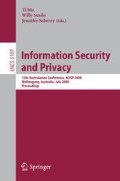Abstract
There has been extensive research focusing on improving CBC-MAC to operate on variable length messages with less keys and less blockcipher invocations. After Black and Rogaway’s XCBC, Moriai and Imai proposed 2-Key XCBC, which replaced the third key of XCBC with its first key. Moriai and Imai “proved” that 2-Key XCBC is secure if the underling blockcipher is a pseudorandom permutation (PRP). Our research shows that it is not the case. The security of 2-Key XCBC can not be proved under the solo assumption of PRP, even if it is a RPR-RK secure against some related-key attack. We construct a special PRP (PRP-RK) to show that the main lemma in [14] is not true and 2-Key XCBC using this PRP (PRP-RK) is totally insecure.
Access this chapter
Tax calculation will be finalised at checkout
Purchases are for personal use only
Preview
Unable to display preview. Download preview PDF.
References
Bellare, M., Kilian, J., Rogaway, P.: The security of cipher block chaining. In: Desmedt, Y.G. (ed.) CRYPTO 1994. LNCS, vol. 839, pp. 341–358. Springer, Heidelberg (1994)
Bellare, M., Kohno, T.: A theoretical treatment of related-key attacks: RKA-PRPs, RKA-PRFs, and applications. In: Biham, E. (ed.) EUROCRYPT 2003. LNCS, vol. 2656, pp. 491–506. Springer, Heidelberg (2003)
Black, J.: The ideal-cipher model, revisited: An uninstantiable blockcipher-based hash function. In: Robshaw, M.J.B. (ed.) FSE 2006. LNCS, vol. 4047, pp. 328–340. Springer, Heidelberg (2006)
Black, J., Rogaway, P.: CBC MACs for arbitrary-length messages: The three-key constructions. In: Bellare, M. (ed.) CRYPTO 2000. LNCS, vol. 1880, pp. 197–215. Springer, Heidelberg (2000)
Black, J., Rogaway, P., Shrimpton, T.: Encryption-scheme security in the presence of key-dependent messages. In: Nyberg, K., Heys, H. (eds.) SAC 2002. LNCS, vol. 2595, pp. 62–75. Springer, Heidelberg (2003)
Bosselaers, A., Preneel, B. (eds.): RIPE 1992. LNCS, vol. 1007. Springer, Heidelberg (1995)
Dworkin, M.: Recommendation for block cipher modes of operation: The CMAC mode for authentication. NIST Special Publication 800-38B (2005), http://csrc.nist.gov/publications/nistpubs/800-38B/SP_800-38B.pdf
FIPS-133. Federal information processing standards publication (FIPS 133). computer data authentication (1985)
Furuya, S., Sakurai, K.: Risks with raw-key maksing - the security evaluations of 2-Key XCBC. In: Deng, R.H., Qing, S., Bao, F., Zhou, J. (eds.) ICICS 2002. LNCS, vol. 2513, pp. 327–341. Springer, Heidelberg (2002)
Iwata, T., Kurosawa, K.: OMAC: One-key CBC MAC. In: Johansson, T. (ed.) FSE 2003. LNCS, vol. 2887, pp. 129–153. Springer, Heidelberg (2003)
Iwata, T., Kurosawa, K.: On the correctness of security proofs for the 3GPP confidentiality and integrity algorithms. In: Paterson, K.G. (ed.) Cryptography and Coding 2003. LNCS, vol. 2898, pp. 306–318. Springer, Heidelberg (2003)
Iwata, T., Kurosawa, K.: On the security of a new variant of OMAC. In: Lim, J., Lee, D. (eds.) ICISC 2003. LNCS, vol. 2971, pp. 67–78. Springer, Heidelberg (2004)
Kurosawa, K., Iwata, T.: TMAC: Two-key CBC MAC. In: Joye, M. (ed.) CT-RSA 2003. LNCS, vol. 2612, pp. 33–49. Springer, Heidelberg (2003)
Moriai, S., Imai, H.: 2-Key XCBC: the CBC MAC for arbitrary-length messages by the two-key construction. In: The 2002 Symposium on Cryptography and Information Security, SCIS (2002) (in Japanese)
Petrank, E., Rackoff, C.: CBC MAC for real-time data sources. Journal of Cryptology 13(3), 315–338 (2000)
Author information
Authors and Affiliations
Editor information
Rights and permissions
Copyright information
© 2008 Springer-Verlag Berlin Heidelberg
About this paper
Cite this paper
Wang, P., Feng, D., Wu, W., Zhang, L. (2008). On the Unprovable Security of 2-Key XCBC. In: Mu, Y., Susilo, W., Seberry, J. (eds) Information Security and Privacy. ACISP 2008. Lecture Notes in Computer Science, vol 5107. Springer, Berlin, Heidelberg. https://doi.org/10.1007/978-3-540-70500-0_17
Download citation
DOI: https://doi.org/10.1007/978-3-540-70500-0_17
Publisher Name: Springer, Berlin, Heidelberg
Print ISBN: 978-3-540-69971-2
Online ISBN: 978-3-540-70500-0
eBook Packages: Computer ScienceComputer Science (R0)

